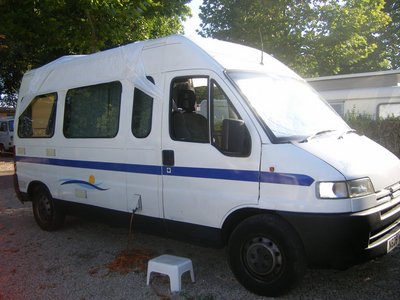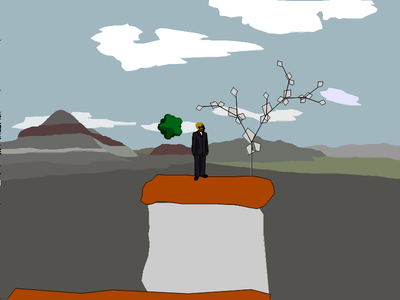

independent software developer

Moose and I are in London for a few days catching up with friends and trying to buy a campervan for our European travels, which should theoretically commence on Wednesday. Things are going quite well and we are enjoying it, not stressing too much. It's been hot and muggy the last couple of days which is weird for me as I haven't been here when it's warm since I was a small kid.
We'll probably head off to France on Wednesday, and see where the wind takes us after that. Croissants! Heh heh.
It's good to be back.
GameJam0808 was awesome fun, which is really what games are all about. In the end I got a crapload of code written, much of which I will be able to re-use again in the future, just as I used quite a bit of old code for my engine. I refined a lot of my existing code, made it more modular, and more re-useable than it was before. I now have a load of generic game code that has been separated from the underlying engine I use, PyGame. It should be easier to switch engines to Pyglet, or something else if I want to in the future.
Huge thanks go to Simon Wittber who organised GameJam, and wrote the entire GameJam site in time for the competition. He also did the awesome procedural audio ambience for my game, and on top of that, he did the most incredibly annoying bit of making a game for me: the deployment.

I didn't finish the game, so it's just one level, and all you can do is run and jump and explore. I can't even really call it an art game because I feel like that would be selling other, really awesome art games short. The vector graphics engine I wrote is massively slow because I didn't have time to optimise anything, which had the side effect of making you fall through floors and stuff on any computer that isn't massively fast. I shouldn't have multiplied all vectors by frame-elapsed time since that number gets really large on those slower computers. Oh well. Good lessons for next time!
Update: the article below is for an Inkscape extension I built a while back for doing animation. For a newer and much better solution for doing frame-by-frame animation in both Inkscape and Adobe Illustrator check out SVG Flipbook. Enjoy!
Inkscape is an awesome, free and open source vector graphics program. It's the free world's version of Adobe's Illustrator program. I can't comment on whether it's better or worse since I've never used Illustrator, but there are many things to love about Inkscape and it's very capable when it comes to vector graphics.
One thing that is hard to come by is a good, free and open source vector animation program. The Inkscape website says that they are looking at introducing animation into the program some time in the future, but who knows how long that will take. I needed to make animated vector graphics for my GameJam 0808 entry, which is a vector graphics platformer, so I knocked together a quick script to do layer based animation in Inkscape. Luckily Inkscape's extensions system is quite extensible, so I was able to write a small Python script that renders each layer separately using Inkscape itself, and then uses Imagemagick's "convert" program to mash the layers together into an animated GIF. Finally, the extension automatically launches the default browser to display the result. This currently only works under GNU/Linux systems with Imagemagick installed, but I'm sure it wouldn't be too big a stretch to get it working on other operating systems.
Here is the Inkscape extension XML file. Place this in your .inkscape/extensions/ directory in a file called gifanimate.inx:
<inkscape-extension>
<_name>GIF Animate</_name>
<id>org.ekips.filter.GIFAnimate</id>
<dependency type="executable" location="extensions">gifanimate.py</dependency>
<dependency type="executable" location="extensions">inkex.py</dependency>
<!-- <param name="what" type="string" _gui-text="What would you like to greet?">World</param> -->
<effect>
<object-type>all</object-type>
<effects-menu>
<submenu _name="Animate"/>
</effects-menu>
</effect>
<script>
<command reldir="extensions" interpreter="python">gifanimate.py</command>
</script>
</inkscape-extension>
Here is the Python script that does all the work. Put this in the same place, and name it 'gifanimate.py'.
#!/usr/bin/env python
import sys, os
sys.path.append('/usr/share/inkscape/extensions')
import inkex
from simplestyle import *
class GIFAnimate(inkex.Effect):
def __init__(self):
inkex.Effect.__init__(self)
def effect(self):
infile = sys.argv[-1]
# Get access to main SVG document element and get its dimensions.
from xml.dom.minidom import parse, parseString
dom = parse(infile)
svg = dom.getElementsByTagName('svg')[0]
layers = svg.getElementsByTagName('g')
pngcommand = "inkscape %s -C -i '%s' -j -e /tmp/%s.png 2>&1 > /dev/null"
layerids = []
delays = []
for l in layers:
bits = l.getAttribute('inkscape:label').split("#")
if not "ignore" in bits:
layerids.append(l.getAttribute('id'))
delays.append(bits[0])
[os.system(pngcommand % (infile, id, id)) for id in layerids]
bits = " ".join(["-delay %d /tmp/%s.png" % (int(delays[x]), layerids[x]) for x in range(len(layerids))])
gifcmd = "convert -loop 0 " + bits + " /tmp/inkscape-anim.gif"
os.system(gifcmd)
import webbrowser
webbrowser.open("file:///tmp/inkscape-anim.gif")
# Create effect instance and apply it.
effect = GIFAnimate()
effect.affect()
To use it go to the 'effects' menu and choose 'Animate > GIF Animate'. Specify frame lengths (in milliseconds) by renaming the layer to the length of time that you'd like each frame to last. Inkscape will add a hash followed by a number for each duplicate entry, but my script will ignore that.

Have fun!